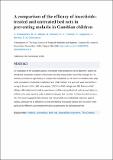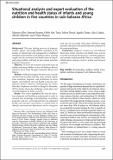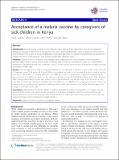| dc.description.abstract | Introduction: Childhood overnutrition is a growing public health issue. It is a significant
risk factor for non-communicable diseases and is becoming increasingly prevalent in low-
and middle-income countries. This study aimed to determine the influence of dietary
practices and physical activity levels on overnutrition among school-going children aged
8–11.
Methods: A cross-sectional design with multistage sampling was employed. A total of 281
children were recruited from five schools. A food frequency questionnaire was used to
assess dietary intake. Physical activity was evaluated using the physical activity
questionnaire for older children. Body mass index (BMI for age and sex) z-score was used
to indicate nutrition status. Univariate, bivariate, and multivariate analysis was applied to
determine associations between the independent variables and overnutrition.
Results: The median age of the respondents was 10 years, and over half (55%) were girls.
Most (66.6%) of the children had adequate nutrition status, while 22.4% and 11% were
underweight and overweight, respectively. There was a notably high frequency of
consumption of foods from grains, plantains, white roots, and tubers (19.2%), as well as
the deep-fried and salty (12%) food groups. About 11.7% of the children consumed
caffeinated drinks. Nearly half (45.2%) of the children were inactive. Overnutrition was
significantly higher among private than public school children (aOR 2.641; 95% CI =
1.013-6.887, p = 0.0047). There was a significantly higher prevalence of overnutrition
amongst children who didn’t walk to school than those who walked, though it was not
statistically significant (aOR 2.017; 95% CI = 0.875-4.650, p = 0.1).
Conclusion: Overnutrition is prevalent among school-going children, particularly in
private schools and those who don't walk to school. The study recommends investing in
nutrition surveillance to understand trends and risk factors and promoting healthy, active
living efforts, including physical activity, sedentary behaviors, and dietary practices, to
enhance school-going children's overall health. | en_US |




